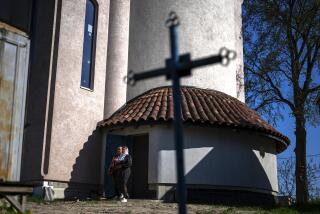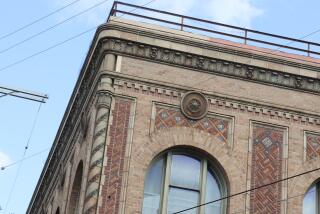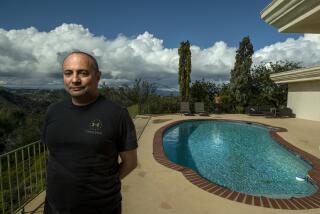Moscow Catholics Locked Out of Their House of Worship
MOSCOW--The imposing pale yellow building with the Soviet stars on its cornices is officially known as the Coal Industry Machine Building Design and Research Institute Joint Stock Co.
But to the robed papal nuncio who raised his chalice this week before a congregation of 400 faithful kneeling on the wet pavement outside its doors, the structure was, is and forever shall be the Roman Catholic Church of Sts. Peter and Paul.
More than a decade after the Soviet Union collapsed, a quiet battle of wills continues over control of the church. The 150-year-old structure located in the center of Moscow once served the capital’s large ethnic German and Polish Catholic populations. During the Communist era, the church was stripped of its crosses and ornaments, nationalized and turned into a movie house and then into offices for the Soviet Union’s thoroughly atheistic national coal monopoly. Now the Catholics want it back.
Despite promises that churches would be returned to their rightful owners after the Soviet collapse, a string of court decisions, apparent bureaucratic indifference and opposition from powerful Russian institutions have stymied the Catholics.
A Mass was celebrated on the structure’s porch Sunday for the feast day of Peter and Paul, to symbolically restate the Catholic claim to the building.
“We beseech you, God, for the return of our temple,” one of the congregants intoned as the pope’s representative in Russia and eight gold-garbed priests prayed with the faithful in a service that lasted more than an hour. The service ended with a symbolic procession around the building.
Among those making the procession was Jadwiga Sinitsyna, 67, a pensioner who was baptized in the church in October 1934 and hopes to worship inside it again before she dies.
The struggle for the property is part of a larger question for the Catholic Church in Russia: how it can eke out a place for itself in a country where many Orthodox Christians regard it as a dangerous interloper, trying to impose the values of Western Christianity on the Slavic heartland.
In the latest sign of tension Monday, the Orthodox Patriarchate issued a statement saying a recent decision to set up Roman Catholic dioceses in Russia amounted to a violation of understandings between the two churches. It accused the Catholic Church of poaching believers and of activities “aimed at expanding the Catholic presence in this country.”
Tension between Catholics and Orthodox burst into the open in February when the Vatican decided to change what had been called “apostolic administrations” in Russia into four full-fledged dioceses.
The Orthodox Church was livid, declaring the move an invasion of its “canonical territory” even though there are far fewer than 1 million Catholics among Russia’s 144 million people. The Orthodox patriarch, Alexi II, labeled the Vatican a “foreign government” bent on setting up “illegal government structures” on Russian soil.
In the aftermath, Catholic parishes became targets for demonstrations. Some foreign clerics, including Polish-born Bishop Jerzy Mazur, found themselves cut off from their flocks when they were stripped of visas and denied entry to Russia. The Vatican says it never received an explanation for Mazur’s expulsion, or even a reply to its appeal for his reinstatement.
Although Russian law gives no preference to the Orthodox faith, other Christian groups have long complained of discrimination and say that state officials are inclined to carry out the wishes of the Orthodox hierarchy. During his visit to Russia in May, President Bush made a point of meeting with Catholic Archbishop Tadeusz Kondrusiewicz at the U.S. ambassador’s residence.
Geraldine Fagan, Moscow correspondent for the Keston News Service, which monitors religious issues in the former Soviet bloc, said that Catholic efforts to regain property such as the Peter and Paul church will be affected by the Orthodox clergy’s anti-Catholic campaign.
“It could go either way,” she said, adding that authorities may be influenced to act against the Catholic Church’s requests. Or, if there is a feeling that “the whole anti-Catholic thing has gone too far,” Catholics might actually benefit from the attention and receive the former church building.
The structure continued serving as a church for 20 years after the 1917 Bolshevik Revolution. It was transformed into a movie house before being given to the coal industry. In 1991, Moscow authorities indicated that the Catholics could get the building back. But that decision was effectively overruled on the federal level. Instead, in 1994, the structure became an asset of the newly privatized coal institute, known by the cumbersome Russian acronym Giprouglemash.
Roman Catholics’ hopes of getting the building back hinge on a court review of whether that privatization was conducted legally, since it involved a structure of cultural importance.
Father Bogdan Sewerynik, a priest from Poland who has been titular pastor of the parish for three years, said that land for the church was donated by a Catholic parishioner in the 1830s and that the property was built “to be a church for centuries to come.”
He himself has never been allowed inside the building, which long ago was divided into a warren of dark little offices for the institute. The only concession to the Catholics, said Sewerynik, is to permit services on its doorstep each June in recent years to mark the Peter and Paul feast day.
“I guess they do not mind it once a year,” the priest said.
Boris K. Myshlyayev, the recently retired director of Giprouglemash, said the Catholics might as well give up.
“The Giprouglemash Joint Stock Co. is the only legal owner of the premises and is not planning to hand it over to the Catholic Church or to anyone else,” Myshlyayev said. “We own the building, and there are no two ways about it.”
He hinted that the real reason that Catholics were never able to reacquire the property is because it is situated close to the Lubyanka, the headquarters of the Federal Security Service, or FSB, the successor to the Soviet KGB.
“The Catholics can write petitions to anyone they want--to the Moscow authorities, to the pope or even to God himself if they know the right address--but they will never get the building back because they will never beat the FSB, which would not like Roman Catholics right next to its headquarters,” he said. “What is so special about this building for them? It does not even look like a church anymore.”
According to Sewerynik, Catholics need more places of worship in Moscow, and so far the city authorities have not come up with any workable alternatives. In all of Moscow, there are only two churches to serve an estimated 40,000 Roman Catholic believers. The diocese would like to have at least three more churches.
“We don’t lose hope,” said Sewerynik about the struggle over the church of Saints Peter and Paul.
“God sees what is going on and eventually he will help us. However, I cannot say for sure how long God will choose to first teach us patience.”
More to Read
Sign up for Essential California
The most important California stories and recommendations in your inbox every morning.
You may occasionally receive promotional content from the Los Angeles Times.










